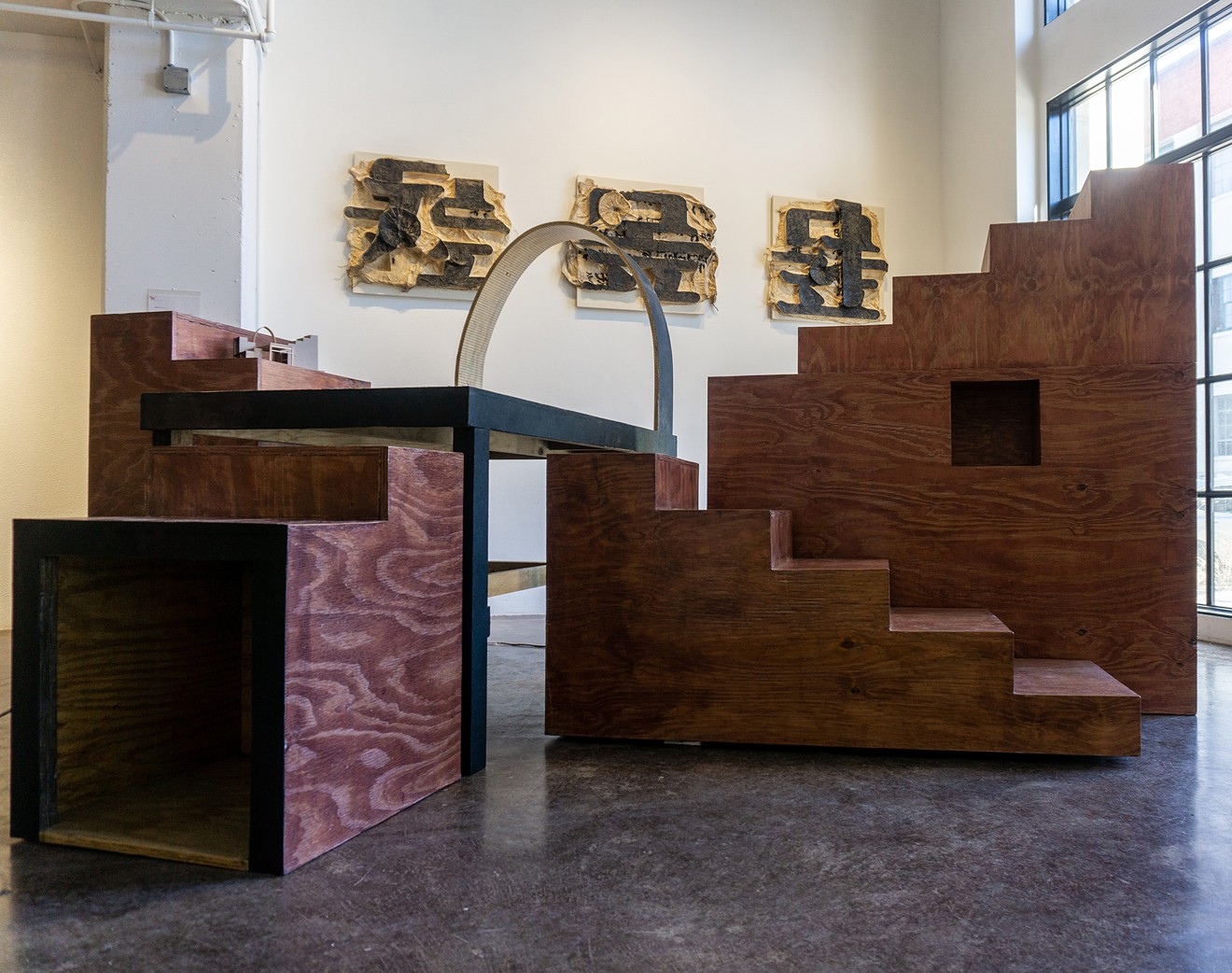At Walker Fine Art, gallery director Bobbi Walker and her crew, headed up by Libby Garon, have taken six artists, all of whom use the written word in some way, and put them together in Synesthetic Ciphers, a large and impressive group show.
It starts off with a bang: a monumental installation by Sammy Lee in the double-height atrium space right inside the front doors. A Colorado-based artist born in Korea, Lee has filled much of the floor with the architectonic construction “Baoli,” which looks something like an elegantly composed children’s playhouse but is actually based on the shape of a traditional Indian step-well. Several elements have been pushed together into a constructivist arrangement: There are rectangular cabinets and enclosures; a two-part staircase with landing, its steps reversing direction halfway up; and a loft stage topped with an arch. Made of plywood, the surfaces are beautiful, with the grain showing through the different tones of the staining used to finish the panels.
Though it passes for a sculpture, this accumulation of components is actually a stage set for a piece for three dancers that was choreographed by Lee, working with Kate Speer and Joowon Song. Beyond the construction is a set of three cast-paper reliefs that spell out “MOP” in calligraphy. Lee rubbed paper over deconstructed and reassembled signs to make the symbol that, seen upside down, forms the word “Poom." While the word “mop” does not exist in the Korean language, the word “poom” does, and it carries multiple, commonly known meanings. The dancers act out some of them in their performance, which you can see in a video by Drummond West. Lee is definitely a rising presence on the scene, and the Denver Art Museum has acquired the cast-paper work for its permanent collection.
In the adjacent space are pieces by Doug Haeussner that look like drippy abstractions from across the room, but on closer inspection reveal themselves to be collages built from torn bits of paper. Haeussner collects old books, magazines and records, and uses their original colors to create a found palette that includes some text. Deidre Adams also incorporates words in elegant, all-over compositions that really are drippy abstractions. In the large “Frame of Reference,” she's scribbled down words that she heard on the radio as she painted, while the older works have marks that look like writing but are illegible.
Five fabulous acrylic-on-paper paintings by the late Roland Bernier feature words and elements that suggest words for their formal attributes as opposed to their meanings. An artist’s artist, Bernier was clearly ahead of his time: These pieces are nearly thirty years old, yet they look as new as anything around. Bernier employed words and, before that, symbols as armatures for the organization of his pictures. Blair Vaughn-Gruler also uses marks to create structure, labyrinthine mazes of lines that cover her two-tone paintings displayed here.
According to Walker, the idea for the show was inspired by Bonny Lhotka’s digital photo-based pieces that combine images, text and three-dimensional elements. In “Dark Night,” for instance, a botanical photo is paired with a poem by Robert Frost that’s printed in English, overlaid by the transparent bumps of a Braille translation. Lhotka has been experimenting with computer-driven photography since the technology was first developed over twenty years ago.
The aesthetic core of the show is established by the Haeussner, Adams, Bernier and Vaughn-Gruler pieces, which make for a very tightly organized group. While the Lee and Lhotka works move out from this center in opposite directions, Synesthetic Ciphers still comes together.

Jeff Horton's "Conveyance" (left) and "Freeway."
Mike McClung, courtesy of Michael Warren Contemporary
There are definitely types of structures being depicted, like skeletal industrial facilities. While these buildings are not rendered accurately and their actual shape is impossible to make out, Horton does begin with tiny photos of actual things, such as details of the armatures of grain elevators or the cages around oil storage tanks. Using the steel frameworks as starting points, he then extends the elements until they cover the surfaces of his typically large paintings. The architectonic imagery is no accident for Horton, instead reflecting a lifelong interest: He's a partner in an architecture firm.
Tucked in the back is Kelton Osborn's A Moment. Osborn is an architect, too, the principal at Quick Bend Design in Denver. In addition to architecture, Quick Bend is involved in many aspects of design, including industrial design and public art. But while Osborn shares a vocation with Horton, the compositions in his mixed-media paintings on paper are much more freely realized, even if there is a little geometry here and there. Osborn is guided by instinct and intuition in drawing and painting the elements of his pieces, and he obviously has a seasoned eye for pictorial balance.

An installation of Kelton Osborn's mixed-media paintings on paper.
Mike McClung, courtesy of Michael Warren Contemporary
Osborn must be finding inner harmony in the process of art-making, because despite his travails, these are some of the most lyrical paintings he’s done over the last decade. To me, they seem a push forward: While still exemplifying his well-established signature style, they are less studied and more spontaneous, and work really well.
There are a lot of eye-dazzling displays around town right now, but the shows at Walker and Michael Warren belong on your don’t-miss list.
Filling the Void, by Jeff Horton, and A Moment, by Kelton Osborn, through February 22, Michael Warren Contemporary, 760 Santa Fe Drive, 303-635-6255, michaelwarrencontemporary.com.
Synesthetic Ciphers, through February 29, Walker Fine Art, 300 West 11th Avenue #A, 303-355-8955
walkerfineart.com.













